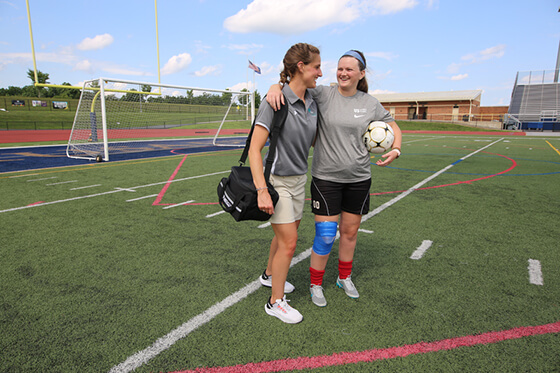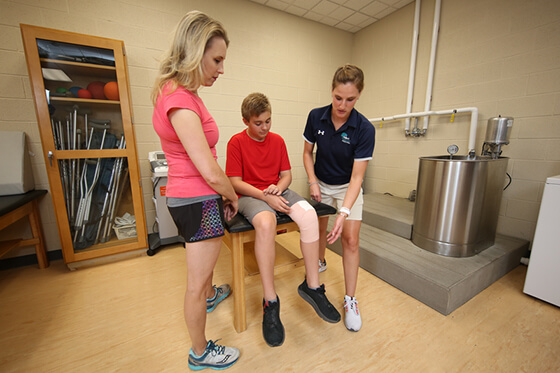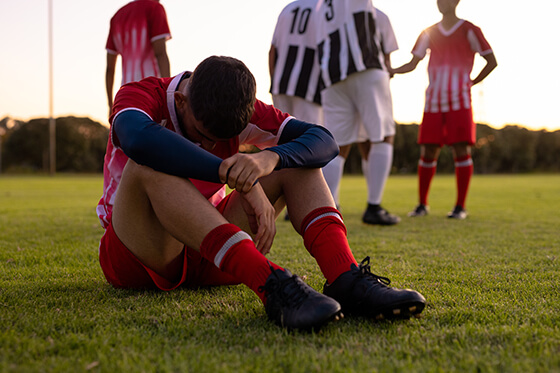Behind closed doors: How athletic trainers empower athletes mentally
Recognizing the hidden role of an athletic trainer
Posted 3/19/24
As a current or former athlete, you know the powerful sound of a loud crowd in the stands when the score is tied. It fills you with adrenaline.
You know the sound of your teammates running up to you on the field with excitement, screaming, “Nice shot” or “You’ve got this.”
You know the sound of the crowd going silent as a player gets injured. And you know the sight of an athletic trainer jumping into action as this is happening.
You might also know the sound of your athletic trainer saying, “I’m here for you; let’s talk about this.”
Many high school athletes, college athletes and even parents of athletes can probably name or remember an athletic trainer who took good care of them or can refer to one as their role model. Some might say that they were closer with their athletic trainer than their coach.
Beyond taping, diagnosing and rehabilitating injuries, athletic trainers serve as invaluable mentors and guides, playing a crucial role in treating an athlete from head to toe.
The life of an athletic trainer
Sometimes it is assumed that athletic trainer duties are limited to running ice baths or taping up a sprained wrist or finger.
Well, that’s only a small portion of what their job encompasses.
While they may not always take center stage like coaches or star athletes, the role of an athletic trainer is crucial in ensuring the health, safety and performance of athletes.
Let’s look at the duties of an athletic trainer and why their contribution is so vital:
- Injury prevention and wellness promotion – Through techniques such as strength and conditioning exercises, proper warm-ups and promotion of injury prevention, they help minimize the risk of injury during training and games. They can also implement injury prevention programs to help educate athletes on their movement patterns and how to reduce their risk of injury in the future.
- Examinations and diagnosis – They take information about an athletes’ previous medical history and follow with an examination that includes observation, range of motion and muscle testing and other specialized tests. After an initial physical examination, they make clinical decisions based on their evaluation. They can then determine if specialized care or further imaging is needed by a medical facility to give or confirm an official diagnosis before treatment begins.
- Emergency care – In the event of an injury, athletic trainers are first responders on the scene, whether it be a volleyball court, ice rink or football field. They provide immediate care and triage, assessing the severity of injuries and determining the appropriate course of action. They help to establish emergency action plans and know advanced first aid, CPR, automated external defibrillator (AED) use and other lifesaving skills.
- Therapeutic intervention – This topic refers to a wide range of techniques and modalities, such as rehabilitation exercises, hands-on manual therapy, compression, taping and bracing. These interventions are designed to address the specific needs of individual athletes and promote healing, recovery and functional restoration following injury.
- Health care administration and professional responsibilities – This is the least seen of all tasks athletic trainers. Athletic trainers in health care administration are responsible for managing the overall operation of the athletic training program within a health care setting, which includes overseeing budgeting, ordering, scheduling and facility management. They also collaborate with other health care professionals, such as physicians and physical therapists, to coordinate comprehensive care for athletes. They are often involved in educating athletes and coaches about injury prevention and wellness strategies, as well as conducting research and staying current with advancements in sports medicine. Athletic trainers are required to complete 50 hours of continuing education every two years.
Indeed, athletic trainers are versatile in many ways, and they do everything they can to provide care to as many athletes as possible.
Where you can spot them
While their presence may be most visible on the sidelines, their scope of practice extends far beyond the boundaries of the playing field.
Athletic trainers make invaluable contributions to multiple areas, such as:
- Clinical settings – Athletic trainers play crucial roles in clinical settings such as hospitals, rehabilitation centers and orthopedic centers. They work with patients of all ages and activity levels, not just athletes, providing services for musculoskeletal injuries, post-surgical care and chronic condition management.
- Industrial and occupational settings – They focus on preventing and managing work-related injuries. Sometimes they collaborate with employers to design ergonomic workstations, conduct job site evaluations to identify potential hazards and develop injury prevention programs tailored to the specific needs of a workforce.
- Military and public safety agencies – They work with service members, firefighters, police officers and other first responders to maintain physical condition, minimize the risk of injuries and provide immediate care in emergency situations.
- Performing arts – Athletic trainers can address musculoskeletal issues, optimize movement mechanics and promote overall wellness for dancers, musicians and actors, who put their bodies through rigorous demands.
As we recognize the importance of holistic health care and injury prevention, the demand for athletic trainers in diverse settings is currently growing, which highlights the versatility of their profession.
The unseen role – helping more than physical pain
So now that you’re familiar with what athletic trainers do and where they do it, it’s time to learn about their lesser known but incredibly invaluable role.
When student-athletes experience mental health issues, they are less likely to seek help and guidance from their coaches and teammates for fear of the consequences.
They mask their anxiety so as to avoid loss of playing time or appearing weak.
Adding to the pressure, athletes are expected to be successful at their sport and in the classroom, as well as serving as role models to younger students and people in the community.
So who do they turn to?
Athletic trainers are sometimes the first to know about difficulty within a students’ life.
They’re usually the first to know when an athlete is considering quitting their sport.
They’re frequently the only one to know that an athlete is struggling mentally and too afraid to speak to anyone else.
That’s the unseen role of an athletic trainer – creating a safe place to land emotionally and mentally as well as being a confidant to handle difficult conversations with athletes.
Athletic trainers serve as invaluable mentors, mental health advocates and guides to student-athletes.
Student-athletes typically spend multiple days, if not every day, with an athletic trainer if they’re being treated for an injury or simply looking to improve at their sport. They get to know one another, build trust and forge a bond that can often last a lifetime.
This is why athletes will turn to their athletic trainer. While they’re busy taping up an ankle, athletic trainers are also:
- Creating a safe space for vulnerability – Athletic trainers often serve as the first point of contact for athletes facing physical and emotional challenges. Because of their trusting nature and outgoing vibe, student-athletes feel comfortable expressing their fears, frustrations and insecurities to an athletic training without feeling judged.
- Implementing mental skills into training – Just as athletes train their bodies to perform at peak levels, they must also train their minds to stay focused and resilient. Athletic trainers often incorporate metal skills training into their rehabilitation program, like positive self-talk, visualization, breathing techniques and mindfulness of emotions to enhance performance and reduce stress levels.
- Offering support during high-stress situations – Athletes face immense pressure to perform at their best, often under the watchful eyes of thousands of spectators. Athletic trainers serve as a calming presence on the sidelines, offering words of encouragement, reassurance and perspective during high-stress situations. They help calm down panic attacks during tryouts or during other tough, mental scenarios. Athletic trainers are seen as trusted sources to athletes because they’re not judging or calling the shots on whether they’re sitting the bench or not.
- Fostering resilience through adversity – Athletic trainers understand that setbacks and failures are inevitable in the world of sports. Whether it’s a season-ending injury or a disappointing loss, they stand by their athletes, providing empathy and guidance during adversity. By helping athletes reframe setbacks as opportunities for growth and learning, trainers instill a sense of perseverance that extends far beyond the realm of sports.
Indeed, mental health issues in secondary schools are a growing concern, and because student-athletes trust their athletic trainers with this kind of information, confidentiality is afforded to the athlete.
Understandingly, there are certain instances and protocols that an athletic trainer must follow if an individual poses a risk to themselves or others. They can help guide at-risk athletes to school counselors and school officials during difficult situations to get them the help they need.
But athletic trainers don’t just see the dark side of mental health. They also see the light through students’ journeys.
They see the freshman soccer player who’s afraid to be aggressive on the field turn into a senior athlete who’s preparing to take the next step into college. They see many freshmen-to-senior journeys and often wonder how it went so fast and how much change has occurred.
They see athletes using the positive, mental strategies and self-talk tips that they provided. They see them not being so hard on themselves and how much they have grown mentally in a span of four years.
All the advice, support and guidance from an athletic trainer helps transform these athletes into young adults by the time they’re ready to graduate.
Athletic trainers want to see growth out of everyone that comes through their door. That’s the ultimate goal.
An athletic trainer will always have an open-door policy throughout the athletes’ school journey to encourage speaking up about situations. They will also always help treat physical injuries and guide athletes mentally.
So, think about an athletic trainer who has influenced your life. You might remember them as a role model or a trusted adult who you could always rely on – maybe as someone who helped you through a tough time in your life. Perhaps an athletic trainer even changed your life for the better.
Make sure to thank them for everything they do throughout the school year and for all the “hats” they wear. They will always be a trusted adult, and they will advocate for both your physical and mental health.
Again, say “thank you,” and give them the recognition they deserve.




